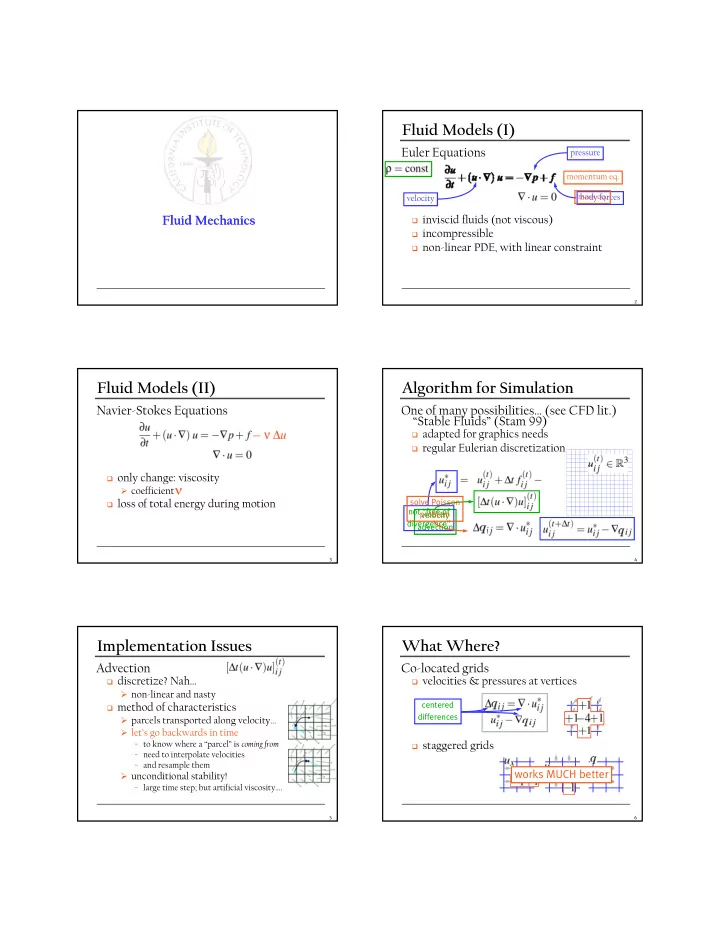

Fluid Models (I) Euler Equations pressure momentum eq. mass eq. body forces velocity inviscid fluids (not viscous) Fluid Mechanics Fluid Mechanics incompressible non-linear PDE, with linear constraint 2 Fluid Models (II) Algorithm for Simulation Navier-Stokes Equations One of many possibilities… (see CFD lit.) “Stable Fluids” (Stam 99) adapted for graphics needs regular Eulerian discretization only change: viscosity coefficient loss of total energy during motion solve Poisson not “free of problem velocity divergence” advection 3 4 Implementation Issues What Where? Advection Co-located grids discretize? Nah… velocities & pressures at vertices non-linear and nasty method of characteristics centered differences parcels transported along velocity… p p g y let’s go backwards in time staggered grids − to know where a “parcel” is coming from − need to interpolate velocities − and resample them works MUCH better unconditional stability! − large time step; but artificial viscosity…. 5 6
u u “Geometry” of Fluids? Geometry Revealed u u p u u p t t Euler equations seem clear Pressure disappears when we take the curl: advection + div-free projection ad infinitum (vorticity) Stam’s Stable Fluids do this wonderfully well numerous follow-up work (Fedkiw et al. ) vorticity measures the “spin” of a parcel but what does it mean, geometrically? , g y vorticity is “advected” along the flow ti it i “ d t d” l th fl “total energy” is rather unintuitive the circulation around any is there a notion of momentum preservation? closed loop is constant Yes as it gets advected (by Stokes) ( t ) u . dl but of course, we need to massage the PDE C ( t ) − known as Kelvin’s theorem so as to reveal the geometric structure − call it preserv. of angular momentum if you want 7 8 Geometry Revealed Towards a Proper Discretization So we know: Domain discretization = simplicial complex Integral of vorticity constant on advected sheet fluxes through faces for velocity Additionally, defines u intrinsic (coordinate-free) and eulerian if we ignore complex topology for a moment » reminiscent of staggered grids… net flux for divergence net flux for divergence b because u is divergence free! d f − what comes in…must come out Vorticity is the only real variable here flux spin for vorticity and Kelvin’s is a defining property Torque created on a “paddle wheel” (Navier-Stokes: loss along the way) valid for any grid… 9 10 Discrete Kelvin’s Theorem Results Guarantees circulation preservation… New method for any discrete loop! exact discrete vorticity preservation big loop = union of small ones arbitrary simplicial meshes … even on curved spaces see also [Feldman et al. ’05, Bargteil et al ’06] everything is intrinsic everything is intrinsic basic operators very simple (super parse) great flows for small meshes! computationally efficient even on coarse mesh no need for millions of vortex particles Difference with Stable Fluids? trace back integrals, not point values 11 12
Channel Smoking Bunny 7k vertices, 32k tets; 0.45s per frame on PIV (3GHz) 13 14 Merging Vortices Movie 15 16
Recommend
More recommend